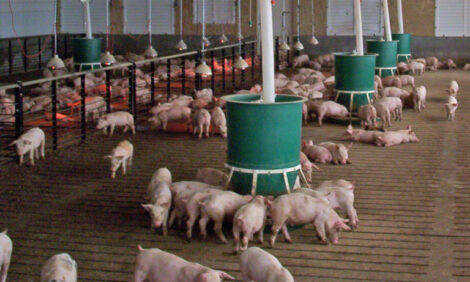



UK/EU Pig Market Update - July 2003.
By the UK's Meat and Livestock Commission - This MLC report looks at the current market situation in the UK and reviews recent price trends and markets throughout Europe.Producer Prices

United Kingdom producer prices peaked in mid-June, and have since fallen sharply. The UK Eurospec price in the week ended 26 July fell to 99p/kg dw, 12p down on four weeks earlier although the alternative DAPP price series (which contains a higher proportion of contract prices, was down just 9p to 102p. The declines seen during July have, however, closely tracked the changes seen at this time in both 2001 and 2002, and are seasonal in nature. Consequently, prices have remained above corresponding 2002 levels, up by 6p in the week ended 26 July.
Market prices this year have generally benefited from a combination of lower throughputs at abattoirs and from the weaker sterling exchange rate relative to the Euro. Sterling continued to weaken in April and May, rising through the 70p barrier. By the end of May the value of the Euro stood at 72.3p, 1.5p above the value at its launch in January 1999 and 9p higher than a year ago. Although sterling fell back to just over 69p during the course of June, it recovered to above 70p during July. Periods of very hot weather hot weather during July had an adverse impact on demand for fresh pork and consequently on producer prices.

Acute shortages of weaner supplies, resulting from breeding herd contraction and problems with sow infertility, meant that prices strengthened considerably during the first few months of 2003. Between April and June the market was fairly stable, at £37-£39 a head, although prices fell sharply in July in line with the weaker finished pig market. The average price of 30kg weaners in late June , at £33 a head, was £4-£5 down on a month earlier.
Reduced sow supplies, particularly from April onwards, and the impact of a weaker sterling have also led to a generally firmer cull sow market this year. Sow prices averaged around 55p/kg dw in April and the first half of May, but they fell back 3-4p in the second half of May amid reports of Germany being swamped with cull sows from Poland. Germany is reported to have remained a difficult market, and cull sow prices have fluctuated within the 50-52p range for much of June and July.

EU prices in Euro firmed slightly in June due to a combination of some shortage of supplies and firmer demand. The average EU reference price in the week ended 20 July was six per cent higher than a month earlier in Euro terms.
There was a marked difference in trend between southern and northern Europe, with the southern European countries benefiting from the holiday trade. Significant increases were recorded in France (up 13%, helped by holiday demand in southern regions), Italy (+26%), Spain (+11%) and Portugal (+12%). In Northern Europe, the difficult export conditions have kept Danish prices depressed, and no change was recorded over the month. German prices increased by one per cent while Dutch prices fell by the same amount.
With the EU price firming and the UK price weakening, the UK price premium over the overall EU price averaged dropped sharply in July. The premium in sterling terms stood at about 8p/kg in the week ended 20 July, 14p down on a month earlier but very similar to the average for 2002.
UK pig meat prices remain significantly higher than in Denmark and the Netherlands, the main overseas suppliers to the UK market, but the difference in prices has fallen during July. Prices in Denmark, where the market has been affected by a sharp drop in export sales to Russia following the introduction of a Tariff Rate Quota in April, are currently 29p lower than the UK price (38p a month ago) while Dutch prices are 21p lower (29p last month).
Slaughterings
Clean pig slaughter levels have been well below corresponding 2002 levels since January. This has arisen in part from a lower breeding herd but more importantly from deteriorating sow productivity. Defra slaughtering statistics for June indicate that UK throughputs averaged around 173,000 head. Preliminary MLC estimates for July are that average weekly throughput was 175,000 head.

Total United Kingdom slaughterings have fallen less markedly than GB slaughterings. This is because of an increase in Northern Ireland, where the breeding herd has been more stable than in Great Britain. Northern Ireland slaughterings have also benefited from some increase in live pig imports from the Irish Republic.

The actual cause of the decline in supplies in Great Britain since the start of the year is unclear. There may well be no single predominant reason, but a number of factors, including:
- Reports of some sporadic increases in PMWS incidence in the early part of 2003.
- Some disruptions to breeding patterns and performance arising from a significant number of producers depopulating and then repopulating last year.
- A developing sow infertility problem since last Autumn, which affected clean pig slaughter levels in the April-June quarter.

Consumption
July saw some spells of very hot weather in the United Kingdom. This hit demand for fresh pork, as well as demand for the other meats. Household fresh and frozen pork volume purchases were down one per cent in the 12-week period ending 20 July compared with a year ago. However the value of retail expenditure was up two per cent due to higher retail prices. Demand for bacon is also adversely affected by hot weather, and bacon volume sales were down six per cent in the 12-week period, while expenditure was five per cent lower. Demand for barbecue and picnic products will have been encouraged by the hot weather. So, for example, volume purchases of pork sausages were up eight per cent while ham and sliced pork sales rose by six per cent.

Source: MLC - August 2003








